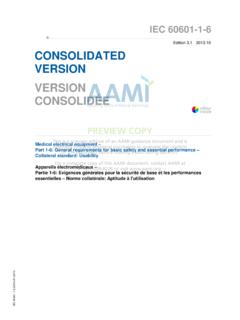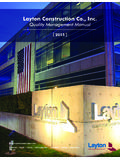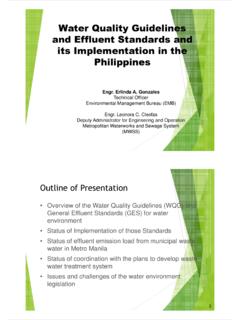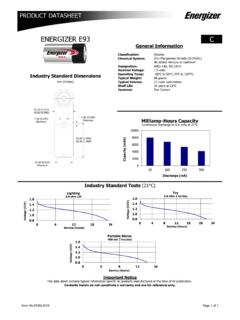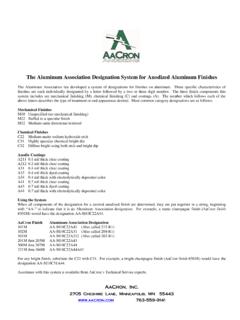Transcription of Dialysis Water and Dialysate Recommendations: A …
1 Dialysis Water and Dialysate recommendations : A User GuideGlenda M. PaynePREVIEW COPYThis is a preview edition of an AAMI document and isintended to allow potential purchasers to evaluate the content of the document before making a purchasing a complete copy of this AAMI document, contact AAMI at +1-877-249-8226 or visit COPYThis is a preview edition of an AAMI document and isintended to allow potential purchasers to evaluate the content of the document before making a purchasing a complete copy of this AAMI document, contact AAMI at +1-877-249-8226 or visit Water and Dialysate recommendations : A User GuideGlenda M. PaynePREVIEW COPYThis is a preview edition of an AAMI document and isintended to allow potential purchasers to evaluate the content of the document before making a purchasing a complete copy of this AAMI document, contact AAMI at +1-877-249-8226 or visit byAssociation for the Advancement of Medical Instrumentation4301 N.
2 Fairfax Drive, Suite 301 Arlington, VA 2014 by the Association for the Advancement of Medical InstrumentationAll Rights ReservedPublication, reproduction, photocopying, storage, or transmission, electronically or otherwise, of all or any part of this document without the prior written permission of the Association for the Advancement of Medical Instrumentation is strictly prohibited by law. It is illegal under federal law (17 101, et seq.) to make copies of all or any part of this document (whether internally or externally) without the prior written permission of the Association for the Advancement of Medical Instrumentation. Violators risk legal action, including civil and criminal penalties, and damages of $100,000 per offense.
3 For permission regarding the use of all or any part of this document, complete the reprint request form at or contact AAMI at 4301 N. Fairfax Drive, Suite 301, Arlington, VA 22203-1633. Phone: +1-703-525-4890; Fax: + in the United States of AmericaISBN 1-57020-518-3 This publication is intended to be a helpful information resource, and reflects the expert advice and views of the editor. It is not to be construed as an interpretation of AAMI standards , nor does it constitute legal or regulatory COPYThis is a preview edition of an AAMI document and isintended to allow potential purchasers to evaluate the content of the document before making a purchasing a complete copy of this AAMI document, contact AAMI at +1-877-249-8226 or visit of Contents PageForeword.
4 VChapter 1 . Introduction ..1 Chapter 2 . Index by Tag Number and Identifier ..7 Chapter 3 . Water and Dialysate quality Crosswalk from the CMS Regulation to the Applicable ANSI/AAMI ISO Recommendation ..11 Chapter 4 . 494 .100 Condition: Care at Home ..149 Chapter 5 . Validation ..163 Chapter 6 . Terms and Definitions Comparison Table ..169 Chapter 7 . Comparison of Tables and Figures ..189 Table 1 from RD52:2004 with Tables 1 and 2 from ISO 23500 .. 190 Table 2 from RD52:2004 with Table from ISO Table 3 from RD52:2004 with Table from ISO 23500 ..194 Table 4 from RD52:2004 with the table in Annex from ISO Figure 1 from RD52:2004 ..201 Figure 2 from RD52 Tables 3, 4, and 5 from ISO Table from ISO 23500.
5 205 Chapter 8 . Table of Differences ..209 Dialysis Water and Dialysate recommendations : A User Guide iii AAMIPREVIEW COPYThis is a preview edition of an AAMI document and isintended to allow potential purchasers to evaluate the content of the document before making a purchasing a complete copy of this AAMI document, contact AAMI at +1-877-249-8226 or visit COPYThis is a preview edition of an AAMI document and isintended to allow potential purchasers to evaluate the content of the document before making a purchasing a complete copy of this AAMI document, contact AAMI at +1-877-249-8226 or visit has long been known that potable Water , suitable for drinking by the general population, can contain substances harmful to Dialysis patients if that Water is used directly to prepare Dialysate .
6 As early as the 1960s, the presence in Dialysate of chemicals commonly found in drinking Water was being linked to the development of a number of hemodialysis-associated comorbidities, including anemia, bone disease and neurological abnormalities. To help protect patients from injury, maximum allowable levels for a range of chemical contaminants, as well as for bacteria, were included in the first edition of the American National Standard for Hemodialysis Systems published by AAMI in 1981. An appendix to the standard provided guidance to Dialysis professionals on how to treat drinking Water to ensure compliance with the quality standards are not static documents; they are subject to regular review and revision as the related science and technology advance.
7 Thus, the hemodialysis systems standard evolved over the years as our understanding of the risks posed to hemodialysis patients by contaminants in drinking Water increased and Water treatment practices changed. For example, introduction of the Limulus amebocyte lysate assay allowed a maximum limit for endotoxin to be added to the Water quality standard in 2001 as we became more aware of the role microbiological contaminants play in Dialysis -associated inflammation. Other changes were spurred by changes in Water treatment practices, such as the replacement of free chlorine by monochloramine for microbial control in drinking Water in response to the Environmental Protection Agency s introduction of an upper limit for trihalomethanes.
8 These changes led to a series of revisions to the AAMI hemodialysis systems standard, culminating in the publication of separate standards for the treatment of Water and the preparation of Dialysate in 2001 and 2004, respectively. Finally, in 2011 those AAMI standards were replaced by adoption of a comprehensive suite of five standards developed by the International Organization for Standardization (ISO) that covered all aspects of fluid preparation for hemodialysis and related therapies and which was based on the existing AAMI standards . It is important to recognize that different parts of that suite of standards are directed at different audiences. standards setting forth requirements for devices and commercially produced fluids, such as concentrates, are directed at manufacturers of those items, while standards setting forth the quality requirements of Water and the Dialysate prepared from that Water , as well as guidance on achieving those quality requirements are primarily directed at the Dialysis professionals responsible for delivering the actual Dialysis Centers for Medicare and Medicaid Services (CMS) is the largest funder of Dialysis therapy in the United States.
9 As part of its oversight activities, CMS requires providers of Dialysis to comply with certain performance criteria intended to promote improved outcomes and ensure the safety of Dialysis patients. These requirements are set forth in the CMS Conditions for Coverage for End Stage Renal Disease Facilities (the CfC). Following publication of the original AAMI Dialysis Water and Dialysate recommendations : A User Guide v AAMIPREVIEW COPYThis is a preview edition of an AAMI document and isintended to allow potential purchasers to evaluate the content of the document before making a purchasing a complete copy of this AAMI document, contact AAMI at +1-877-249-8226 or visit standard in 1981, CMS then known as the Health Care Financing Administration made compliance with the Water quality standard part of the CfC.
10 That requirement was limited to complying with the maximum allowable contaminant levels and the guideline for monitoring Water purity. Nevertheless, it is likely that inclusion of the AAMI Water quality standard in the CfC promoted widespread acceptance of the standard and helped protect hemodialysis patients from harm during a time when patient numbers were increasing rapidly and significant changes were occurring in municipal Water treatment CfC is published as a Federal Regulation and changing it can be a long process involving publication of a proposed new regulation, a period of public comment on that proposal, publication of responses to the public comments, review by other governmental entities, such as the Office of Management and Budget, and publication of a final regulation.
